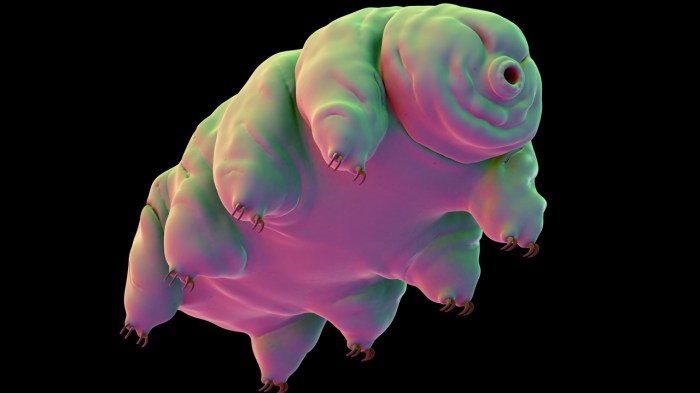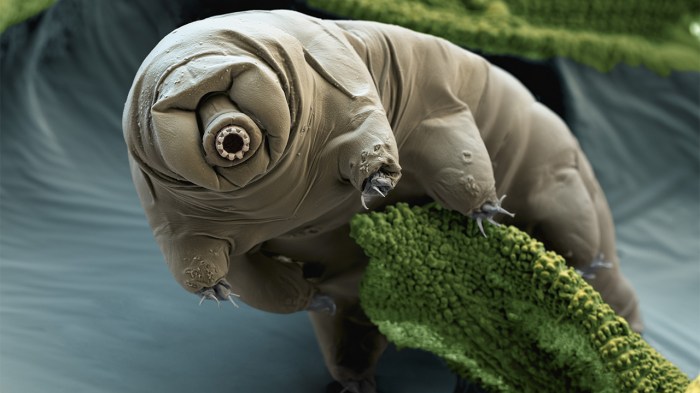Introduction to Tardigrades and Radiation Resistance: Water Bear Protein Protect Human Radiation
Tardigrades, also known as water bears or moss piglets, are microscopic animals renowned for their extraordinary resilience. These fascinating creatures possess an exceptional ability to withstand extreme environmental conditions, including high doses of radiation, that would be lethal to most other life forms. Their remarkable survival skills have sparked significant interest in the scientific community, prompting investigations into the underlying mechanisms responsible for their radiation resistance.
The significance of tardigrade radiation resistance lies in its potential applications for human health and technological advancements. Understanding the molecular mechanisms behind their survival could pave the way for developing novel strategies to protect humans from the damaging effects of radiation, whether from medical treatments, space travel, or environmental hazards. Furthermore, their unique biological properties could inspire the development of radiation-resistant materials and technologies, particularly in fields like electronics and space exploration.
The Role of Proteins in Tardigrade Radiation Resistance
Tardigrades’ remarkable ability to withstand radiation is attributed, in part, to the presence of specific proteins that protect their cells from damage. These proteins act as molecular shields, safeguarding vital cellular components from the destructive effects of radiation.
- Damage Repair Proteins: Tardigrades possess a diverse array of proteins that efficiently repair DNA damage caused by radiation. These proteins work by identifying and mending broken DNA strands, preventing the accumulation of mutations that could lead to cell death.
- Antioxidant Proteins: Tardigrades produce high levels of antioxidant proteins that neutralize harmful reactive oxygen species (ROS) generated by radiation. These proteins act as scavengers, mopping up ROS before they can damage cellular structures.
- Stress-Induced Proteins: Tardigrades produce unique proteins that are specifically induced by exposure to radiation. These proteins play a crucial role in protecting cells from stress, promoting survival under harsh conditions.
Key Proteins Involved in Tardigrade Radiation Resistance
Tardigrades, also known as water bears, are microscopic animals renowned for their incredible resilience to extreme conditions, including high doses of radiation. Their ability to survive such harsh environments is attributed, in part, to the presence of specific proteins that protect their cells from radiation damage. These proteins play crucial roles in repairing damaged DNA, scavenging free radicals, and maintaining cellular integrity.
Damage Suppression Proteins (Dsup)
Dsup, a protein unique to tardigrades, is a key player in their radiation resistance. It is a small, highly conserved protein that binds to DNA and protects it from damage caused by ionizing radiation.
Dsup binds to DNA in a non-sequence-specific manner, forming a protective shield around the genetic material.
Studies have shown that Dsup can significantly reduce DNA damage and enhance cell survival in human cells exposed to radiation. While the exact mechanism of Dsup’s action is still being investigated, it is believed to work by:
- Directly binding to DNA: Dsup’s structure allows it to bind to DNA, creating a protective barrier against radiation-induced damage.
- Modulating DNA repair pathways: Dsup may interact with other proteins involved in DNA repair, enhancing their efficiency and effectiveness.
- Reducing oxidative stress: Dsup may also contribute to reducing oxidative stress, a major factor in radiation damage, by scavenging free radicals.
Other Important Proteins
Besides Dsup, other proteins contribute to tardigrade radiation resistance. These include:
- Superoxide dismutase (SOD): This enzyme plays a crucial role in scavenging reactive oxygen species (ROS), which are highly damaging molecules produced during radiation exposure. SOD converts superoxide radicals, a major type of ROS, into hydrogen peroxide, a less harmful molecule.
- Catalase: Catalase is another important enzyme involved in the detoxification of ROS. It breaks down hydrogen peroxide into water and oxygen, further reducing oxidative stress.
- Heat shock proteins (HSPs): These proteins are involved in protein folding and repair, protecting cells from damage caused by stress, including radiation. HSPs help to refold damaged proteins, preventing their aggregation and maintaining cellular function.
Potential Applications of Tardigrade Proteins in Human Radiation Protection
The remarkable radiation resistance of tardigrades, often called water bears, has sparked intense scientific interest in harnessing their unique capabilities for human benefit. Scientists are actively exploring the potential of tardigrade proteins to develop novel radiation protection strategies, paving the way for groundbreaking advancements in medicine, aerospace, and the nuclear industry.
Potential Applications in Medicine
The discovery of tardigrade proteins like Dsup (Damage Suppressor) and others that shield DNA from radiation damage has opened doors to innovative applications in medicine. These proteins hold immense promise for mitigating the harmful effects of radiation therapy on healthy cells during cancer treatment. By harnessing the protective power of tardigrade proteins, researchers aim to develop targeted therapies that minimize collateral damage to healthy tissues, thereby improving patient outcomes and reducing side effects.
Potential Applications in Aerospace
The harsh radiation environment of space poses a significant threat to astronauts during long-duration missions. Tardigrade proteins could play a crucial role in safeguarding astronauts from the damaging effects of cosmic radiation. Integrating these proteins into protective gear or developing novel radiation shielding materials could significantly enhance astronaut safety and enable extended space exploration.
Potential Applications in the Nuclear Industry, Water bear protein protect human radiation
The nuclear industry faces constant challenges in protecting workers from radiation exposure. Tardigrade proteins could offer a revolutionary approach to radiation protection in nuclear power plants and other facilities. By incorporating these proteins into protective clothing or developing specialized radiation shielding, workers could be better protected from the risks associated with radiation exposure.
Challenges and Opportunities
While the potential applications of tardigrade proteins are promising, several challenges remain.
- One major hurdle is understanding the complex mechanisms by which these proteins protect against radiation damage. Further research is needed to unravel the intricate interactions between tardigrade proteins and cellular processes.
- Another challenge lies in effectively delivering these proteins to target cells and tissues in a safe and efficient manner.
- Furthermore, the ethical considerations surrounding the use of animal-derived proteins in human applications must be carefully addressed.
Despite these challenges, the opportunities presented by tardigrade protein research are vast. With continued research and development, these remarkable proteins could revolutionize radiation protection strategies and unlock new possibilities for human health and safety.
Ethical Considerations and Societal Implications
The potential use of tardigrade proteins for human radiation protection raises significant ethical and societal concerns. While the benefits of such technology are undeniable, careful consideration of the risks and implications is crucial before widespread implementation.
Potential Benefits and Risks
The application of tardigrade proteins in human radiation protection offers a range of potential benefits, including:
- Enhanced protection against radiation exposure for individuals working in high-risk environments, such as nuclear power plants, space exploration, and medical imaging.
- Improved treatment outcomes for cancer patients undergoing radiation therapy by minimizing side effects and enhancing treatment efficacy.
- Development of novel therapeutic strategies for radiation-induced injuries, potentially leading to faster recovery and improved long-term health.
However, alongside these potential benefits, several risks and ethical considerations must be addressed:
- Potential for unintended consequences: The introduction of foreign proteins into the human body could trigger unexpected biological responses, leading to unforeseen health risks.
- Equity and access: The cost of developing and deploying this technology could create disparities in access, potentially benefiting only those with financial resources.
- Ethical considerations regarding genetic modification: The use of tardigrade proteins could raise concerns about genetic engineering and the potential for unintended consequences on future generations.
Societal Implications
The development of tardigrade protein-based radiation protection has the potential to significantly impact society in various ways:
- Impact on human health and safety: This technology could revolutionize radiation protection, leading to safer working conditions for individuals in high-risk environments and potentially reducing the incidence of radiation-induced diseases.
- Economic implications: The development and commercialization of this technology could create new industries and jobs, driving economic growth and innovation.
- Social and ethical debates: The potential benefits and risks of this technology will undoubtedly spark public debates about ethical boundaries, genetic engineering, and the responsible use of scientific advancements.
Water bear protein protect human radiation – The study of tardigrade proteins and their potential for human radiation protection is still in its early stages, but the possibilities are truly remarkable. As we continue to unravel the secrets of these tiny creatures, we may be able to unlock new avenues for safeguarding human health and expanding our reach into the cosmos. It’s a journey that promises to be both fascinating and potentially life-saving.
Remember those tardigrades, the microscopic creatures that can survive anything? Turns out, their secret weapon is a protein that could protect us from radiation too. While we’re waiting for that breakthrough, you can at least get your hands on the latest tech with the iphone 7 7 plus pre order live. Maybe one day, your future iPhone will have built-in tardigrade protection, making you as invincible as these tiny superheroes!
 Standi Techno News
Standi Techno News

